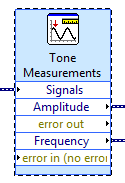- Subscribe to RSS Feed
- Mark Topic as New
- Mark Topic as Read
- Float this Topic for Current User
- Bookmark
- Subscribe
- Mute
- Printer Friendly Page
Finding width of FFT peak
06-10-2016 01:13 AM
- Mark as New
- Bookmark
- Subscribe
- Mute
- Subscribe to RSS Feed
- Permalink
- Report to a Moderator
Hi,
i have a signal with single peak at a particular frequency.
Now i wish to filter out that peak using a bandstop filter.
However, for that I need to find the bandwidth of that peak which is observed. (in frequency domain obviously)
Is there any way I can do that?
06-10-2016 02:45 AM
- Mark as New
- Bookmark
- Subscribe
- Mute
- Subscribe to RSS Feed
- Permalink
- Report to a Moderator
@Bgmnt wrote:
Hi,
[..]
Is there any way I can do that?
Sure. The question is what you expect to get.
The first thing is that your signal has to be free of alias frequencies. Otherwise, all analysis is non-sense.
The second thing is that the resolution of the frequency correlates to the resolution of the time. That means: the higher your sampling rate, the better your frequency resolution will be after the transformation (FFT). => "Bandwidth of the peak" makes only sense if the width is greater than the resolution of the frequency.
When using the Peak Detector.vi, you could evaluate the width input and 2nd derviate output if that includes data you are looking for.
Norbert
----------------------------------------------------------------------------------------------------
CEO: What exactly is stopping us from doing this?
Expert: Geometry
Marketing Manager: Just ignore it.
06-10-2016 04:26 AM
- Mark as New
- Bookmark
- Subscribe
- Mute
- Subscribe to RSS Feed
- Permalink
- Report to a Moderator
I am using tone measurement block for measuring tone frequency.
Isnt peak detection used for time domain signals?
06-10-2016 04:31 AM
- Mark as New
- Bookmark
- Subscribe
- Mute
- Subscribe to RSS Feed
- Permalink
- Report to a Moderator
Also width is an input in peak detector vi. I want to display the bandwidth as an output .
06-10-2016 05:45 AM
- Mark as New
- Bookmark
- Subscribe
- Mute
- Subscribe to RSS Feed
- Permalink
- Report to a Moderator
Please read the help for Peak Detector.vi.
This function works on arrays arrays. It doesn't matter if the array reflects data of time or frequency domain.
Norbert
----------------------------------------------------------------------------------------------------
CEO: What exactly is stopping us from doing this?
Expert: Geometry
Marketing Manager: Just ignore it.
06-14-2016 12:43 AM
- Mark as New
- Bookmark
- Subscribe
- Mute
- Subscribe to RSS Feed
- Permalink
- Report to a Moderator
Hi.
width is an input to peak detector vi
I want the width of the peak as a n OUTPUT. that is i want to findth the range of frequencies that it spawns so that i can filter that out using bandstop filter of the detected bandwidth
06-14-2016 01:11 AM - edited 06-14-2016 01:12 AM
- Mark as New
- Bookmark
- Subscribe
- Mute
- Subscribe to RSS Feed
- Permalink
- Report to a Moderator
use waveform analysis multi scale peak detection vi...
There are two ways to tell s thanks in forums : either give Kudos or Marked Solutions
06-14-2016 01:12 AM
- Mark as New
- Bookmark
- Subscribe
- Mute
- Subscribe to RSS Feed
- Permalink
- Report to a Moderator
also
"Peak detection is one of the most important time-domain functions performed in signal monitoring".
as mentioned by NI "http://www.ni.com/white-paper/3770/en/"
06-14-2016 01:14 AM
- Mark as New
- Bookmark
- Subscribe
- Mute
- Subscribe to RSS Feed
- Permalink
- Report to a Moderator
Rizwan,
width is an input for this too.![]()
06-14-2016 07:03 AM - edited 06-14-2016 07:14 AM
- Mark as New
- Bookmark
- Subscribe
- Mute
- Subscribe to RSS Feed
- Permalink
- Report to a Moderator
Use peak detect to find it, then just fit a Gaussian to the peak. You can then calculate the FWHM.

